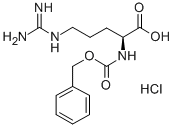L-Arginine hydrochloride
Synonym(s):α-Amino-δ-guanidino valerianic acid hydrochloride, alpha-Amino-delta-guanidino valerianic acid hydrochloride, Arg;(S)-(+)-2-Amino-5-[(aminoiminomethyl)amino]pentanoic acid monohydrochloride;(S)-(+)-Arginine hydrochloride;L -Arginine monohydrochloride;Arg, HCl
- CAS NO.:1119-34-2
- Empirical Formula: C6H15ClN4O2
- Molecular Weight: 210.66
- MDL number: MFCD00064550
- EINECS: 214-275-1
- SAFETY DATA SHEET (SDS)
- Update Date: 2025-12-19 17:28:17

What is L-Arginine hydrochloride?
Description
L-Arginine hydrochloride is a salt form of L-Arginine, where hydrochloric acid is added to enhance stability and solubility. Arginine hydrochloride is a L-alpha-amino acid. An essential amino acid that is physiologically active in the L-form. L-Arginine might be effective at lowering blood pressure, reducing the symptoms of angina and PAD , and treating erectile dysfunction due to a physical cause.
Chemical properties
White crystalline powder
The Uses of L-Arginine hydrochloride
gastric acid depressant
The Uses of L-Arginine hydrochloride
An essential amino acid for human development. Precursor for nitric oxide. Ammonia detoxicant (hepatic failure); diagnostic aid (pituitary function).
The Uses of L-Arginine hydrochloride
L-Arginine monohydrochloride is used in the treatment of heart and circulatory diseases. It is a precursor of nitric oxide synthesis that induces vasodilation in vivo, there by relaxing blood vessels. It is also used in the treatment of angina and other cardiovascular problems. It is an important intermediate in the urea cycle and involved in the detoxification of nitrogenous wastes. It is commonly used in cell culture media and drug development.
What are the applications of Application
L-Arginine Monohydrochloride is a precursor of nitric oxide synthesis that induces vasodilation in vivo
Definition
ChEBI: Arginine hydrochloride is a L-alpha-amino acid.
brand name
R-Gene 10 (Pharmacia & Upjohn).
Biochem/physiol Actions
L-Arginine is considered as a semi essential amino acid. In most mammals including humans, L-Arginine synthesis occurs through intestinal-renal axis, from glutamine, glutamate and proline. Abnormal levels of L-Arginine is associated with the development of kidney and cardiovascular disease. L-arginine is found to decrease fat mass and visceral adiposity.
Side Effects
L-arginine has some potential side effects to consider when taking it as a supplement. Some of the more common and benign side effects can include: nausea, diarrhea, bloating, and abdominal pain. However, L-arginine may result in some serious complications.
Safety Profile
Moderately toxic by intraperitoneal route. Mildly toxic by ingestion. An experimental teratogen. When heated to decomposition it emits very toxic fumes of NOx and HCl.
Purification Methods
A likely impurity is ornithine. Crystallise the salt from H2O at pH 5-7, by adding EtOH to 80% (v/v). [Greenstein & Winitz The Chemistry of the Amino Acids J. Wiley, Vol 3 p 1841 1961, Beilstein 4 IV 2649.]
Properties of L-Arginine hydrochloride
| Melting point: | 226-230 °C(lit.) |
| Boiling point: | 235℃[at 101 325 Pa] |
| alpha | 22 º (c=8,6N HCl) |
| Density | 1.42 |
| vapor pressure | <1 Pa (20 °C) |
| FEMA | 3819 | L-ARGININE |
| storage temp. | 2-8°C |
| solubility | H2O: 100 mg/mL |
| form | powder |
| pka | 1[at 20 ℃] |
| color | white |
| Odor | odorless |
| PH | 5.5-7.0 (25℃, 1M in H2O) |
| PH Range | 5.5 - 7 |
| optical activity | [α]20/D +22.0±0.5°, c = 5% in 5 M HCl |
| Water Solubility | Soluble in water. Slightly soluble in hot alcohol. |
| Sensitive | Hygroscopic |
| λmax | λ: 260 nm Amax: ≤0.2 λ: 280 nm Amax: ≤0.1 |
| Merck | 14,780 |
| BRN | 3631658 |
| Stability: | Stable. Incompatible with strong oxidizing agents. |
| CAS DataBase Reference | 1119-34-2(CAS DataBase Reference) |
| EPA Substance Registry System | L-Arginine, monohydrochloride (1119-34-2) |
Safety information for L-Arginine hydrochloride
| Signal word | Warning |
| Pictogram(s) |
 Exclamation Mark Irritant GHS07 |
| GHS Hazard Statements |
H315:Skin corrosion/irritation H319:Serious eye damage/eye irritation |
| Precautionary Statement Codes |
P305+P351+P338:IF IN EYES: Rinse cautiously with water for several minutes. Remove contact lenses, if present and easy to do. Continuerinsing. |
Computed Descriptors for L-Arginine hydrochloride
L-Arginine hydrochloride manufacturer
MSC Chemicals
Techno Pharmchem
Chemfield Inc
ASM Organics
New Products
Indole Methyl Resin tert-butyl 9-methoxy-3-azaspiro[5.5]undecane-3-carboxylate Boc-His(Boc)-OH 2-CTC Resin 4-Chloro-7-tosy1-7Hpyrrolo[2,3-d]pyrimidine 5,7-Dibromo-1H-indole 2,5-dichloro-N-hydroxy-4,6-dimethylpyridine-3-carboximidamide 2,2-Dimethoxy-7-azaspiro[3.5]nonane hydrochloride 4-chloromethyl-5-methyl-1,3-dioxol-2-one (DMDO-Cl) R-2-BENZYLOXY PROPIONIC ACID 1,1’-CARBONYLDIIMIDAZOLE 1,1’-CARBONYLDI (1,2-4 TRIAZOLE) N-METHYL INDAZOLE-3-CARBOXYLIC ACID 4-((2-hydroxyethyl)thio)benzoic acid 1-(TERT-BUTOXYCARBONYL)-2-PYRROLIDINONE Methyl 6-methylnicotinate 3-Pyridineacrylic acid tert-Butyl carbazate TETRAHYDRO-2H-PYRAN-3-OL 2-((4-morpholinophenylamino) (methylthio) methylene) malononitrile 3-(4-morpholinophenylamino)-5-amino-1H-pyrazole-4-carbonitrile 2,4-dihydroxybenzaldehyde 1,3-Diethyl-1,3-Diphenylurea Methyl 2-methylquinoline-6-carboxylateRelated products of tetrahydrofuran








You may like
-
 1119-34-2 L-Arginine monohydrochloride, 99% 98%View Details
1119-34-2 L-Arginine monohydrochloride, 99% 98%View Details
1119-34-2 -
 L-Arginine monohydrochloride, 99%+ CAS 1119-34-2View Details
L-Arginine monohydrochloride, 99%+ CAS 1119-34-2View Details
1119-34-2 -
 L-Arginine Hydrochloride extrapure CHR CAS 1119-34-2View Details
L-Arginine Hydrochloride extrapure CHR CAS 1119-34-2View Details
1119-34-2 -
![H-Arg-OH·HCl [for Protein Research] CAS 1119-34-2](https://img.chemicalbook.in//Content/image/CP5.jpg) H-Arg-OH·HCl [for Protein Research] CAS 1119-34-2View Details
H-Arg-OH·HCl [for Protein Research] CAS 1119-34-2View Details
1119-34-2 -
 H-Arg-OH·HCl CAS 1119-34-2View Details
H-Arg-OH·HCl CAS 1119-34-2View Details
1119-34-2 -
 L-Arginine monohydrochloride 99% CAS 1119-34-2View Details
L-Arginine monohydrochloride 99% CAS 1119-34-2View Details
1119-34-2 -
 L-Arginine monohydrochloride CAS 1119-34-2View Details
L-Arginine monohydrochloride CAS 1119-34-2View Details
1119-34-2 -
 L-ARGININE MONOHYDROCHLORIDE For Biochemistry CAS 1119-34-2View Details
L-ARGININE MONOHYDROCHLORIDE For Biochemistry CAS 1119-34-2View Details
1119-34-2
